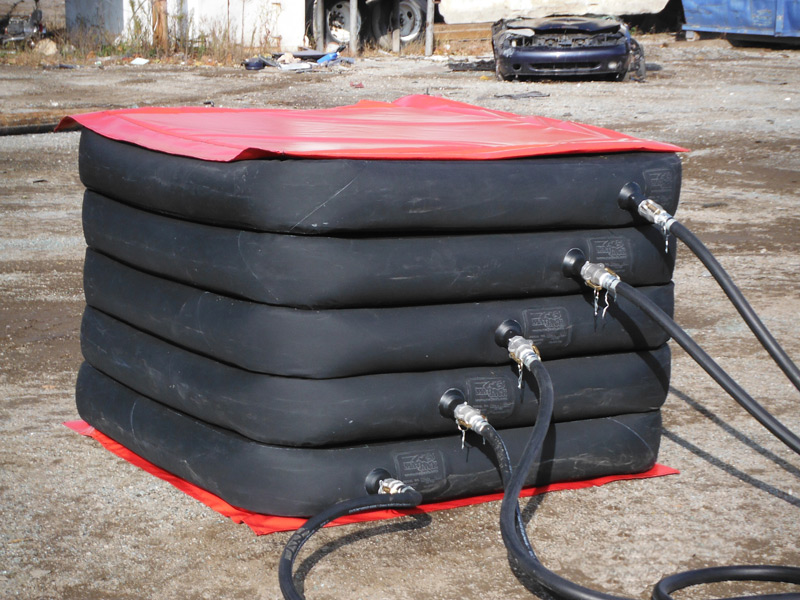Efficient material handling is the backbone of productivity in industrial operations. Whether moving heavy machinery, transporting raw materials, or managing inventory, streamlined material handling processes are crucial for optimizing efficiency and ensuring profitability. However, traditional methods often fall short of meeting the demands of modern industries.
Did you know? Inefficient material handling can result in significant downtime, increased labor costs, and reduced productivity. In today’s fast-paced business environment, companies constantly seek innovative solutions to overcome these challenges and stay ahead of the competition.
Enter Hovair Systems, a pioneer in the field of material handling equipment. With over 50 years of industry experience, Hovair Systems has established itself as a trusted provider of cutting-edge solutions for bulk material handling. Our air bearing systems offer unparalleled versatility, portability, and eco-friendliness, making them the go-to choice for industries seeking to optimize their material handling operations.
In this blog, we’ll delve into strategies for transforming bulk material handling operations to enhance productivity, efficiency, and profitability. From leveraging automated handling systems to optimizing paper roll handling equipment, we’ll explore innovative solutions to common challenges faced by industries dealing with heavy loads.
1. Leveraging Automated Handling Systems
In today’s rapidly evolving industrial landscape, adopting automated handling systems has become indispensable for companies seeking to enhance efficiency, reduce costs, and improve safety in their material handling operations.
With advancements in robotics, artificial intelligence (AI), and software integration, automated handling systems offer myriad benefits that are reshaping traditional approaches to material transport and logistics.
Let’s delve deeper into the various components and advantages of leveraging automated handling systems:
Incorporating Automated Conveyor Systems:

Automated conveyor systems are the backbone of modern material handling operations, facilitating the seamless transportation of goods throughout the facility.
These systems consist of a network of conveyors equipped with sensors, motors, and controllers that enable automated movement and sorting of products.
- Automated conveyor systems eliminate the need for manual intervention in the transportation process, reducing labor costs and minimizing the risk of human error.
- These systems enhance efficiency and throughput by optimizing the flow of materials and streamlining production processes, ultimately improving overall productivity.
- Advanced features such as barcode scanning, weight sensing, and RFID technology enable real-time tracking and traceability of products, enhancing inventory management and order fulfillment capabilities.
Implementing Robotic Palletizers:
Robotic palletizers revolutionize the stacking and packaging of products, offering unmatched speed, accuracy, and flexibility compared to manual methods. These robotic systems are equipped with end-of-arm tooling (EOAT) designed to handle various products and packaging formats with precision.
- Robotic palletizers can efficiently stack products onto pallets according to predefined patterns, optimizing space utilization and reducing packaging waste.
- With the ability to handle heavy loadsand operate at high speeds, these systems significantly increase throughput and production output, driving greater efficiency and profitability.
- Integrated vision systems and AI algorithms enable robots to adapt to dynamic environments and easily handle irregularly shaped or fragile products, ensuring consistent quality and reliability.
Utilizing Automated Guided Vehicles (AGVs):
Automated guided vehicles (AGVs) are autonomous mobile robots that navigate predefined routes within the facility to transport materials, components, and finished products. These versatile vehicles can be programmed to perform various material handling tasks, from simple point-to-point transportation to complex assembly line operations.
- AGVs offer precise and reliable material transport within the facility, reducing the need for manual labor and minimizing the risk of accidents and injuries associated with traditional forklifts and pallet jacks.
- These autonomous vehicles can operate 24/7 without breaks or supervision, maximizing uptime and productivity in the facility.
- AGVs are equipped with sensors and collision avoidance systems that enable safe navigation in crowded or dynamic environments, ensuring the safety of both workers and equipment.
Investing in Warehouse Management Software (WMS):

Warehouse management software (WMS) plays a crucial role in optimizing inventory control and order fulfillment processes in automated material handling environments. These software solutions provide comprehensive visibility and control over warehouse operations, enabling companies to manage inventory levels, track product movements, and streamline real-time order processing.
- WMS platforms integrate seamlessly with automated handlingsystems, enabling data exchange and communication between different components of the material handling infrastructure.
- These software solutions utilize advanced algorithms and predictive analytics to optimize inventory storage and replenishment strategies, minimizing stockouts and overstock situations.
- WMS platforms offer customizable reporting and analytics capabilities that provide valuable insights into warehouse performance, enabling companies to identify bottlenecks, inefficiencies, and areas for improvement.
Ready to optimize your material handling operations? Browse our range of innovative solutions at Hovair Systems and discover how we can transform your business.
2. Optimizing Paper Roll Handling Equipment
In industries that rely heavily on paper products, such as printing, packaging, and publishing, the efficient handling of paper rolls is paramount to maintaining smooth production flows. However, traditional methods of paper roll handling often involve manual labor and outdated machinery, leading to inefficiencies, safety hazards, and potential damage to the valuable paper stock.
Companies are turning to specialized equipment and innovative solutions to address these challenges and optimize paper roll handling operations. In this section, we will delve deeper into the strategies for optimizing paper roll handling equipment to improve efficiency, safety, and productivity in paper-intensive industries.
Introducing Specialized Paper Roll Handling Equipment:
Specialized paper roll handling equipment is designed specifically to meet the unique needs and challenges of handling paper rolls of various sizes and weights. These systems offer a range of features and capabilities tailored to the requirements of paper-intensive industries, including printing presses, packaging facilities, and paper mills.
- Roll handling equipment is equipped with specialized mechanisms, such as adjustable clamps and mandrels, to grip and transport paper rolls securely without causing damage or deformation.
- These systems are designed to accommodate a wide range of roll sizes and weights, providing flexibility and versatility in handling different types of paper stock.
- Advanced safety features, such as overload protection and automatic braking systems, help prevent accidents and injuries during the handling process.
Implementing Roll Handling Solutions with Ergonomic Features:
The manual handling of heavy paper rolls can pose significant risks to workers, including musculoskeletal injuries, fatigue, and repetitive strain. To mitigate these risks and ensure the health and well-being of employees, companies are investing in roll-handling solutions equipped with ergonomic features.
- Ergonomic roll handling equipment is designed with user-friendly controls, adjustable height settings, and padded handles to minimize strain and discomfort for operators.
- These systems incorporate lifting aids, such as hydraulic or pneumatic assist mechanisms, to reduce the physical exertion required to lift and maneuver heavy paper rolls.
- By promoting proper body mechanics and reducing ergonomic stressors, ergonomic roll-handling solutions help improve worker safety, productivity, and morale.
Utilizing Air Caster Material Handling Solutions:

Incorporating Customizable Handling Systems:
Every paper-intensive industry has unique requirements and production environments that demand tailored handling solutions. Customizable handling systems offer the flexibility and adaptability needed to meet these diverse needs and ensure optimal performance in different applications.
- Customizable roll handling systems can be tailored to accommodate specific roll sizes, weights, and production processes, maximizing efficiency and productivity.
- These systems are designed with modular components and flexible configurations, allowing for easy integration with existing equipment and workflows.
- Companies can optimize their paper roll handling operations by working closely with manufacturers to design and implement customized handling solutions and achieve greater efficiency and profitability.
3. Enhancing Heavy Load Handling Systems
Heavy load handling is a critical aspect of various industries, from manufacturing to construction. The movement of oversized equipment, machinery, and materials requires precision, efficiency, and safety.
Traditional methods like cranes and forklifts have long been relied upon for this task, but they come with limitations that hinder productivity and increase risks. Companies are turning to advanced heavy load handling systems equipped with innovative technologies like air caster technology to address these challenges.
Don’t let inefficiencies hold your business back. Contact us today to schedule a consultation and experience the difference with Hovair Systems’ industry-leading material handling solutions.
Investing in Advanced Heavy Load Handling Systems:
One of the key advancements in heavy load handling technology is the incorporation of air caster systems. Unlike traditional methods that rely on wheels or tracks, air caster technology utilizes a cushion of air to lift and move heavy loads with minimal friction. This innovative approach allows for effortless movement of heavy loads across various surfaces, including uneven terrain and delicate flooring.
- Air caster systems distribute the weight of the load evenly, reducing the risk of damage to both the load and the flooring.
- These systems offer greater maneuverability and precision, enabling operators to navigate tight spaces and complex environments easily.
- By minimizing friction and resistance, air caster technology significantly reduces the force required to move heavy loads, resulting in lower energy consumption and reduced wear and tear on equipment.
Implementing Modular Handling Solutions:

Flexibility and scalability are essential factors in heavy load handling operations, where the size and weight of loads can vary significantly. Modular handling solutions offer a versatile approach to accommodate these variations while maintaining efficiency and productivity.
- Modular handling systems consist of interchangeable components that can be easily configured and reconfigured to suit the specific requirements of different loads.
- These systems are designed to adapt to changing needs, allowing for seamless integration with existing infrastructure and workflows.
- Companies can streamline maintenance and repair processes by standardizing modular components, minimizing downtime and maximizing uptime.
Leveraging Remote-Controlled Handling Equipment:
Incorporating remote-controlled handling equipment adds another layer of flexibility and precision to material transport operations. Remote-controlled systems enable operators to manipulate heavy loads from a safe distance, reducing the risk of accidents and injuries associated with manual handling.
- Remote-controlled handling equipment allows operators to navigate hazardous or hard-to-reach areas without putting themselves in harm’s way.
- These systems offer greater precision and control, minimizing the risk of damage to the load and surrounding infrastructure.
- Remote monitoring and diagnostics capabilities enable real-time performance tracking and troubleshooting, ensuring optimal efficiency and reliability.
Integrating Real-Time Monitoring and Tracking Systems:
Ensuring the safety and security of heavy loads during transit is paramount. Real-time monitoring and tracking systems provide visibility and insight into the status and location of loads throughout the handling process.
- Real-time monitoring systems utilize sensors and telemetry technology to collect data on load weight, position, and environmental conditions.
- By integrating GPS tracking and RFID tagging, companies can monitor the movement of heavy loadsin real-time, enabling proactive decision-making and response.
- These systems provide valuable insights into load-handling operations, enabling companies to identify inefficiencies, optimize workflows, and enhance overall performance.
The key to transforming bulk material handling operations lies in embracing innovation and leveraging cutting-edge technologies. Companies must adapt to stay competitive, whether it’s automated handling systems, specialized paper roll handling equipment, or advanced heavy load handling solutions.
At Hovair Systems, we understand the challenges industries face dealing with heavy loads. We offer a comprehensive range of material-handling solutions designed to optimize productivity, efficiency, and safety. From air caster systems to paper roll handling equipment, our products are engineered to meet the diverse needs of our clients and enhance their operational capabilities.
Contact us today to learn how we can revolutionize your material handling operations and take your business to new heights.
